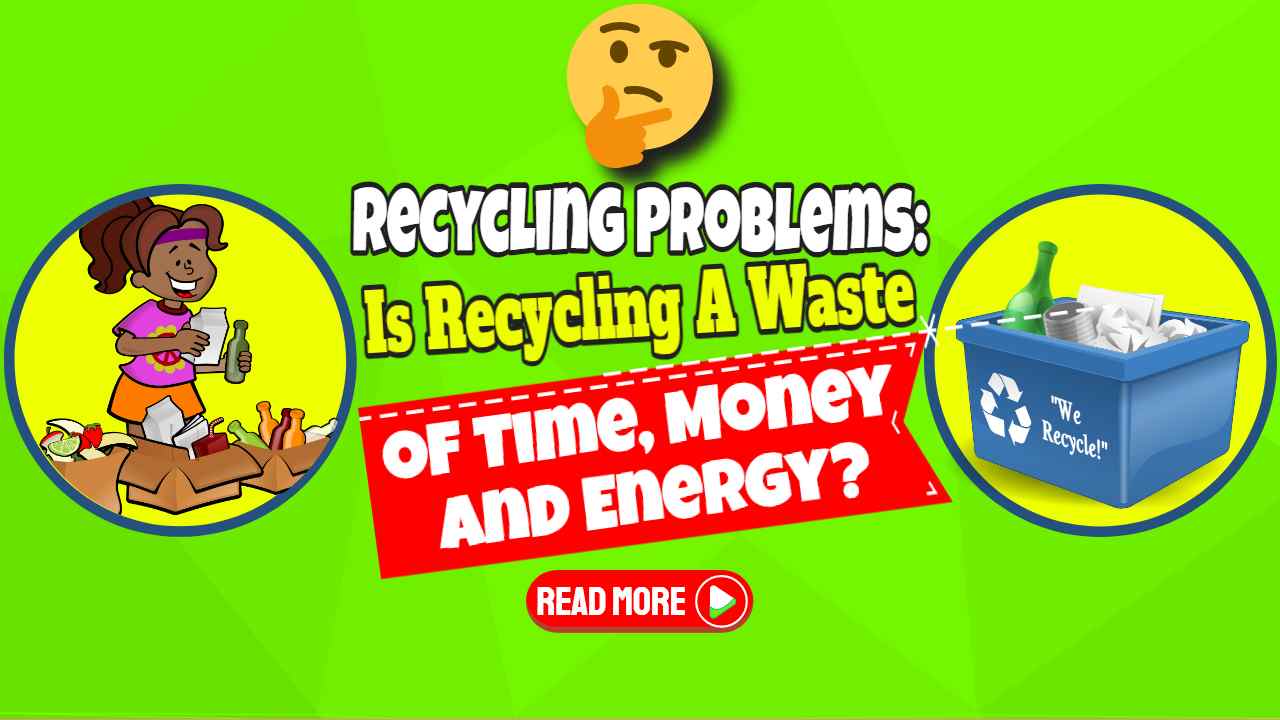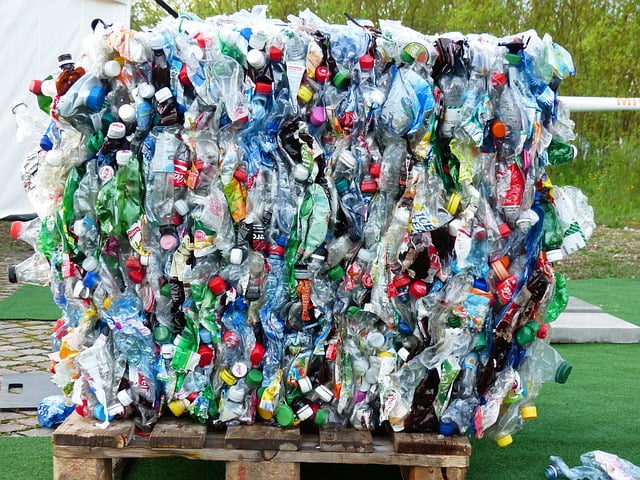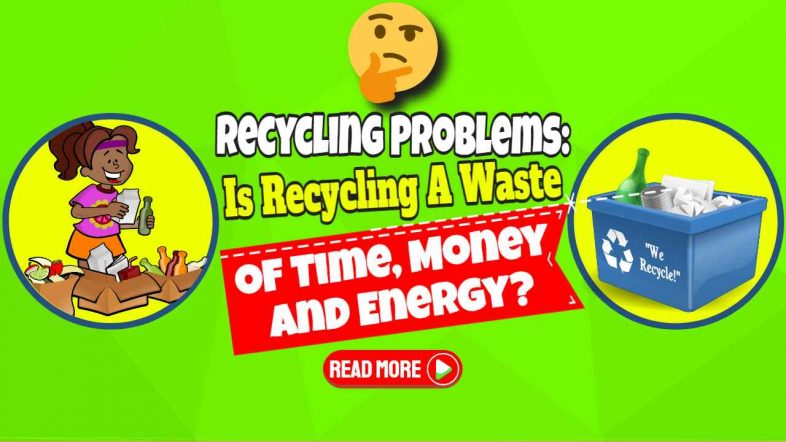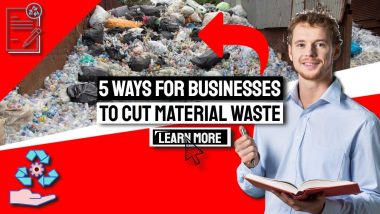With so many recycling problems people are asking; “Is Recycling a Waste of Time, Money and Energy? So, we set out to provide our views on this subject in the article below.
What's the problem with recycling? One word: Plastics
Whatever the way things get sorted, many things aren't reusable. You sort your rubbish out but much of it you put it into your landfill (residual waste or black bag) bin because you cannot recycle it. It seems crazy but such are the rules your council gives you.
So recycling does work. But's not that simple, especially with plastics. Almost all experts agree that reusing recyclable material can save significant energy and water while increasing recycling efficiency and decreasing carbon emissions. Finite resources can stay in the ground, and that's really good as well.
It's easy to say that recycling has so many problems that surely recycling is a waste of time, money and human energy?
A poor state of recycling: Challenges in the US
Environmental issues exist worldwide but particularly America's recycling infrastructure is frequently highlighted in spotlights. In the US. In America, recycling is mainly about collecting recyclable materials in processing facilities and making remanufacturing material into new products and processes for recycling.
Geographic location has a significant impact on recyclable quality. For example, the quality of recyclable materials the residents provide in Seattle and the rest of the Pacific Northwest is generally very high. But, there is a wide range of quality across the country.
Kitchen sinks are not the only thing travelling down the waste sorting line conveyors at MRFs and ERFs these days. Complete rolls of wire, in particular, have the potential to seriously damage equipment if they become entangled in the moving equipment and other objects.

Why is recycling a problem in the US?
What's wrong is that most recyclables can't be recycled at the majority of regional waste management facilities. The result is that the average householder often becomes too sceptical about the waste they are dumping into the garbage. Unfortunately, it happens that the waste ends up somewhere else anyway and it is expensive to have someone else sort it out at the recycle centre.
Some materials, like aluminium cans, glass, and paper, are relatively simple to repurpose (Nearly three-quarters of this type of waste sees a new life as a consumer product.)
Plastic, on the other hand, is a particular issue. In 2018, less than a third of the 29 million tonnes of plastic waste collected in the EU was recycled. A quarter was disposed of in landfills, and the remaining 43% was burned in incineration plants.
“Plastic recycling is largely a fraud, ”
said Jim Puckett, executive director of the Basel Action Network, a non-governmental organisation in the United States that works to end the illegal waste trade.
“It’s been sold to us as being the answer to all the plastic waste and consumption, but in fact, it really has some fundamental aspects of non-circularity that are going to plague that myth and dream forever.”
Plastic industry companies don't want to hear that. As public worry over plastics grows, the industry is concerned that their product could become as forbidden as tobacco.
No Central Policymaking has Led to Confusion About What Can and Cannot be Recycled
This ambiguity is exacerbated by the fact that the United States lacks a federal recycling programme, instead, the government is relying on states to enforce their own rules.
Americans, and the residents of many other nations, are arguably left with little direction on how to recycle in the absence of a federally mandated recycling rule to follow.
Without a federal recycling programme, recycling decisions are currently made by 20,000 communities across the United States, each of which makes its own decisions about whether or not to recycle.
How did we get here?
When recycling first came to the market during the '80s things changed. Until that time American waste management companies recycled products in a multi-stream process that allows different recyclable materials to go in different sorting lines to a degree, but almost all went to landfills.
Plastic packaging was hard to separate. The people spent time sorting out the trash, removing labels and sifting the recyclables from plastic bottles, but the machinery could not cope. It could not even see black plastic, and the only plastics recycled were items easily washed by the public such as plastic milk bottles and a small proportion of drinking water PET bottles.
In truth, plastic recycling was failing even in those days, but it was manageable.
All this changed in the late 20th century. In an economy where manufacturing grew, China wanted everything the country could get so they took the world's mixed recyclables no matter what the quality. Chinese imports grew and they were made of and wrapped in more and more plastic. No concern was raised as it was so cheap and easy to return all that waste to China.
The demand for cheap imported goods and lax Chinese environmental laws transformed global recycling into much more of a single-stream in waste plastics. Single stream back to China!
The Waste Management Industry
The waste industry is massive. It includes a number of $250 billion worldwide companies dedicated to extracting every last penny of value from what's left of your possessions.
A waste management company will one day own everything you own now. The process begins with MRFs (Material Reprocessing Facilities), which separate garbage into its component elements.
Why recycling doesn't work in the U.S
Some recyclable items can become contaminated if even a single unwanted and dirty container is put out of place in recycling bins. The presence of contaminants is a problem preventing the recycling of large quantities of material. Other materials may not be recycled at a particular place just because they are too dirty!
A large portion of collectables like straws, plastic bags, convenience food containers, yoghurt containers and takeouts cannot be easily recycled. They are taken to US landfills and may be destroyed by being incinerated. But the largest proportion is tossed in drains and sewers, enter sewage systems and eventually are drained by rivers into the sea.
While some industries use incineration for producing energy, waste-to-energy these plants can be toxic to the soil in the ground nearby if their chimneys are not pre-filtered and impurities removed.
The sad fact is that in most nations although most of us put things safely into the recycling bins, most are not recycled.
The recycling process in the United States varies by state, but it essentially consists of collecting recyclable materials, processing these materials at a processing facility, and remanufacturing materials into new products.
However, the challenges that the United States faces are not entirely due to the recycling process itself, but rather to a lack of knowledge about recyclable materials, an outdated recycling infrastructure, and a weak domestic market.
Tell me the solution?
There is a greater awareness of the dangers of plastic pollution and a realisation that in geological timescales all plastics will end up in the sea, just as high mountains erode to become just hills, and their rock becomes the mud sand and silt in all rivers.
From that and the effects of climate change becoming clear to all, the fragility of our planet is now immediately apparent in weather events all around us. The result is a huge change in public opinion pushing for more recycling and people are willing to put themselves out to a degree to help.
Globally there are more recycled products in production, or in development, that are designed to be easily reclaimed and recycled in a timely fashion than ever before. The use of plastic bags by supermarkets and other shops has dropped massively where a tax-charge has been placed on their use.
The global demand for paper and cardboard is increasing fast. That's due to the public rebelling against plastic use in the packaging of the products they buy. Recyclable paper can provide a solution to the problem of plastics. If used instead of plastic packaging paper is a natural renewable product and easily incinerated or composted.
But recycling paper is a necessity. The global plastic recycling industry could reach $14.75 billion over the period 2020-2022. The reason for such growth is that companies have begun to reduce the plastic in their packaging materials.
According to the EPA's website, domestic markets for recycled materials in the United States need to be strengthened, and there is a need to “better integrate recycled materials and end-of-life management into product and packaging designs.”
What you can do?
We have to find new business models which will help us reduce consumption in the first place.
As a consumer, every one of us can choose to buy renewable and recyclable products in preference to plastic and more wasteful products.
We can each do our best to re-use materials where possible
China's decision not to accept global contaminated substances began in 2018 and has been tightened progressively since. This should eventually be beneficial to the United States' recycling sector as the value of the recycled products should again rise due to the cost of disposing of residual waste (“black bag” garbage) once again rising.
Purging plastics
The recycling industry has been failing for more than two decades. China's decision to reject its plastics is being followed by a public revolt against plastic pollution. The public is increasingly aware that apart from plastic pollution it takes fossil fuel (non-renewable energy) to make each plastic bottle or container made or recycled.
This prompts us to question whether recycling can be made to work?
How are things going? Not very well in 2022!
The public needs government help to get more comfortable with recycling our stuff.
We need clear and consistent recycling bin labelling and sorting criteria for all, that is logically based and easy to understand.
People should be encouraged t make a habit of composting if they have large enough yards.
The guesswork needs removing over what you need to do when sorting your waste, especially plastic waste.
Learning what your local municipality recycles is just too hard right now, and as soon as you move or go on holiday the rules differ.
Governments must step in and if necessary put limits on the unnecessarily wide range of different plastic types used. Which plastics to recycle is just way too complicated right now. It must all be brought back to a level of complexity the public can learn and apply.
However, we need to go larger. Even if our recycling stories are correct, we are still seeing plastic as our main problem.
Recycling is Only Part of the Picture
Recycling forces consumers to accept responsibility for managing their plastic waste rather than questioning why we need single-use plastics in the first place, especially when alternatives exist.
Aluminium and glass, for example, can have lower carbon footprints, can be recycled infinite times and do not leak dangerous contaminants like plastics.
In Europe, recycled plastics account for only about 6% of the total demand for resin. According to recyclers, the main issue is competition from cheap virgin plastic.
Will EPR Solve us from Fossil-fueled Plastic Pollution?
Why is plastic pollution so widespread today?
This is mainly because plastic waste recycling is at such a low level proportionately that it has no impact on reducing our environmental impacts, the plastic industry.
Industry advocates say that reducing waste will occur through raising the requirements of what is called EPR (think of it as “Environmental Pollution Responsibility”). Under EPR regulations in Europe, the producer is required in principle to pay for the recycling of their own products. The idea is that manufacturers that create hard to recycle and polluting products will have to pay more for them to be returned to them at the end of the life of their products.
If applied widely enough and policed well by the other manufacturers in every industry it could work well. it would be a form of self-regulation. It also makes sense as the materials returned in their old worn-out products will most likely be exactly the materials they need to re-use and make new products.
In this way, EPR could be the driver which forces all industries to become part of the much-lauded “circular economy”.
The Waste Hierarchy
We should know about that inverted triangular image (the “Waste Hierarchy”) which represents a utopia where reduce, reuse, and recycle all get applied in the best way to save the environment.
This triangle must really form a line from best to least harmful waste disposal option with “reducing” the best option in the upper left corner. The term reuse follows. The next, and by no means the best option on this line is recycling. Contrary to public belief recycling certainly isn't the only waste management step to make us happy, and is not even the best!
But Plastics Recycling is at Least Growing!
Between 2020 and 2024, the global plastic recycling market is expected to grow by $15 billion. As a result, companies are attempting to improve the quality of recycled plastic and incorporate it into the plastic products they manufacture.
Plastic waste, particularly PET and HDPE, is recycled into packaging, building and construction materials, electronics, automotive, furniture, textiles, and other products. The key to reviving recycling in the United States is to expand the domestic market.
The following is our still relevant article as published in 2007:
Guest Author: Davis Green

I am going to be very politically incorrect and discuss the recycling problems, and whether recycling might actually be a waste of time, money and energy.
There are many problems with recycling. Few are talking about them.
Most of us feel guilty if we do not take the trouble to wash and sort all those reusable plastics, papers and tins, but should we?
We do this to avoid throwing these items into the residual (what is left over – black sack) bin, which then ends up in the landfill sites around the country. But how useful is recycling and can it really solve the “waste crisis”?
UK households generate a staggering thirty million tonnes of rubbish a year. (All statistics given were correct as of the date of original publication May 2007). Of this, sixty per cent comes from packaging. There has been a lot of publicity recently about the waste that has been put out for recycling ending up in landfill sites.
It is also clear that an increasing amount is being shipped to other countries to dispose of. It can be cheaper to transport it to other countries than to recycle it or fill up the landfill sites in the UK, but this just creates recycling problems for the future.
The European Union (EU) has recently ordered the citizens of the United Kingdom to roughly double their recycling rates by 2008. Governments across the European Union and America have announced plans to require more recycling. Unless the UK hits these targets, local council tax bills across the UK will soar unless local authorities hit their recycling targets to enable the UK to hit their targets set by the EU.
The UK government already charges Landfill Tax for dumping waste in landfill sites to encourage us to recycle more and this tax is due to increase.
The recycling problems here arise because this will punish local councils which continue to use landfills and council taxpayers will pay the price for poor performance by not recycling themselves or by not having the facilities to do this.
It's, therefore, cheaper to recycle than to dump in landfill sites. The UK currently recycles 22 per cent of its household waste (in 2007) while some other EU countries recycle more than half. The UK proposes cutting the amount of waste put into landfill sites from 72 per cent today to 25 per cent by 2020.
Why Bother to Recycle with these Recycling Problems?
1. Hasn't Anyone Heard of Sustainable Forestry?
Why do we use all that energy recycling paper to save the trees? When you look at most newspapers you will find that they tell us that they are buying their paper from sustainable sources, and their tress will re-grow and provide more paper forever.
The keen recycler will argue that paper should be recycled so that we save trees and forests.
But, this is all wrong. Growing more trees to make more paper is not a problem. Why recycle it?
They now grow trees for us in the US, just to produce newsprint and other items. Doesn't that mean that paper is a sustainable resource already?
Paper that is sustainably produced, can't be a recycling problem to start with. I really don't understand why we are expected to recycle it?
Why not just burn the paper and make electricity and heat.
2. Don't The Recyclers Know About Landfill Gas? – Making More Landfills Provides More Landfill Gas Renewable Energy
New landfills are being constructed all the time in the USA. This should happen in the UK on a large scale. By doing this in the UK, we would be able to pipe the methane gas that the landfills produce to local power plants supplying homes with electricity 24/7 in a green and ecological way. That's not hard? So what is the point of recycling?
3. Where is the Common Sense in So Much Recycling?
In other walks of life, decisions are made on economics, after studying the full facts. This seems a completely unknown concept to the government and the EU. They should be looking at each type of waste in turn and base their decision on proper studies which include the WHOLE cost of recycling versus landfilling not only economic but also:
- The energy needed to collect and treat the material and quantity of greenhouse gas this will generate.
- Whether the world will ever actually run out of the raw material (for example glass is made from silicate rock which exists in such vast quantities it is inconceivable this will ever run out).
- The pollution created by the use of energy and equipment to treat the material for recycling.
If a study is undertaken and it concludes that it costs more to recycle in any of these ways, society should not be recycling.
Why not bury the used, and manufacture fresh new products from scratch, if a proper study shows it isn't worth the effort?
If scientists think some materials may run out, we could create landfills just for those materials. One for plastic, one for glass etc. If in the future, we do run out of them our children can dig them all up in one go and only do the recycling, when it makes sense to do it!
For example, if the throwing away of plastic continues and continuing oil shortages mean that it is more cost-effective, we can recycle them all at once by mining the landfills. It would be cheaper and easier than continuous recycling.
4. Lack Of Recycling Collections and Other Problems with Recycling
There are many more recycling problems. The following are just a few:
At present (2007), only an estimated fifteen per cent of UK households have access to kerbside collections, if these collections do not cover glass, paper, plastic etc. then how far are you expected to drive to get to the nearest recycling centre?
How much do you have to store up into a single load at home to ensure that you are not doing more damage to the environment by driving to a recycling centre, than the amount of energy you are saving by recycling?
A lot of people must be unintentionally increasing the overall environmental damage of a product by the waste of energy used in order to travel to their recycling centre (HWRC). That's a problem with recycling!
What about the financial cost to collect the recycling or to take it to the recycling centre?
What about the energy taken to recycle it? Is oil really running out? How much landfill is available?
Conclusion
It's a pleasant feeling when you recycle. It's nice to feel we do it for our planet's sake. Doing it reinforces our feeling that we can all modify our habits. It confirms to us our own environmentally-friendly habits. We can even point out when others aren't recycling (shame on you!).
However, it's possible that this positive outlook is only a placebo effect.
Recycling is better than tossing anything away, however, a lot of our recyclables end up in landfills or the oceans (literally billions of tonnes), wreaking havoc on the ecosystems of the world. And, most damaging of all. It's been estimated that only 9% of all plastic in the world is recycled.
About the Author: David Oglaza is the founder of the Green and Ethical business GuideMeGreen. [Link removed April 2018- website no longer available.]
A Waster's Guest Article: (We thought that we would bring in a guest article with an opinion to air. Let us know what you think… )
[Article originally published in May 2007.]







